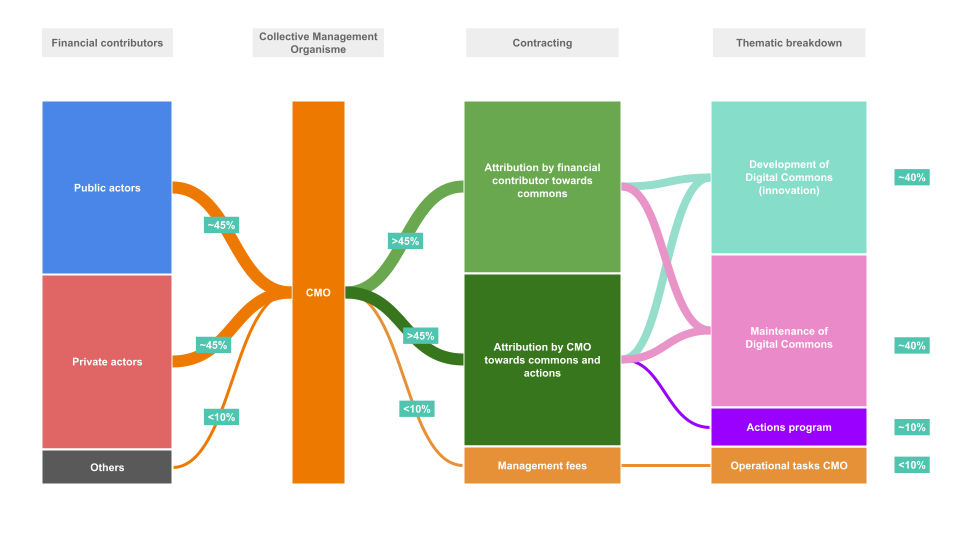
Collect and redistribution
Distinguish work, author, broadcaster, and editor
A "two-sided market" type approach
The notion of apportionment contracts to integrate the particularities of the stakeholders
Main concepts
The parallels with other cultural industries are as follows:
- Work (individual or collaborative): 1 free software (=== 1 song)
- Author : 1 developer / designer (=== 1 artist)
- Broadcaster : 1 entity/administration deploying free software (=== 1 radio station)
- Editor : 1 private company developing a free product (=== 1 production house)
General mecanism
- Authors : authors must register, and declare which free works they contribute to
- Works : you need a catalog of works (free software, free databases) on which you can track contributions
- Broadcasters : they must declare which works they broadcast, and they must contribute financially to a common fund (via agreements). This contribution can be imagined in different ways, cumulatively:
- contributions
- and/or flat-rate contribution
- and/or flat-rate contribution per community
- and/or indexation on a budget allocated to the development of common areas
Distribution of collected funds

A1/ Process from the commons broadcasters side
A broadcaster is considered to be a legal or physical entity ready to voluntarily pay a sum in order to remunerate the authors and co-authors of one or more publications.
A broadcaster signs a commons apportionment contract with the OGC, the OGC undertakes to redistribute the amounts voluntarily paid by the broadcaster.
The contract indicates an amount of voluntary contribution on one or more common areas, or even without a particular common area, all over a given period.
This contract may include redistribution clauses and rules
The contract is then broken down by amounts allocated per year and per common.
All contracts and their associated amounts are aggregated by common, this constitutes one fund per common (and per year)
A2/ The concept of apportionment contracts
Upstream - that is to say with respect to the financial contributors (process A/) - it would be possible to associate with each financial contribution apportionment contracts specifying the different uses of the sums, the conditions and rules of redistribution, as well as the shares allocated to specific common areas or on the contrary without precise marking.
We could imagine that each financial contribution could be associated with a contract specifying:
- one or more shares marked on one or more common areas chosen by the contributor/broadcaster, due to their direct interest in delegating maintenance for the proper functioning of their own services.
- a floor share without signage, with a view to redistribution chosen by the OGC to other “ low level ” or low visibility commons (share which could for example be donated to entities such as Thanks.dev or equivalent).
B/ Process from the authors’ side
An author registers with the OGC, specifying which works/communities he contributes to.
A contract for the transfer/management of copyright is established between the OGC and the author.
Its contributions to commons are calculated and recorded during the year, common by common
At the end of the year, his contributions make it possible to calculate the amount of remuneration allocated to him, common by common, according to the associated fund and the redistribution rules.
The OGC establishes its copyright declaration with the authorities and sends the proof of declaration to the author
Note : the process on the author's side is the one that needs to be as fast and automated as possible in order to avoid any administrative burden and exponential management costs.
C/ Special case of digital commons editors
A commons editor employs one or more employees, considered to be the initial authors of the published commons
The editor is considered the manager of the copyright of its employees.
The editor allows the management of rights in his name by the OGC with the URSSAF
The editor registers its employees as authors on the OGC
The OGC calculates and declares the remunerations to the authors as in B/, with the particularity of declaring these sums to the authorities in the name of the editor also but sends the documents to the editor
Simplified full data model
See the markdown document on the repository.